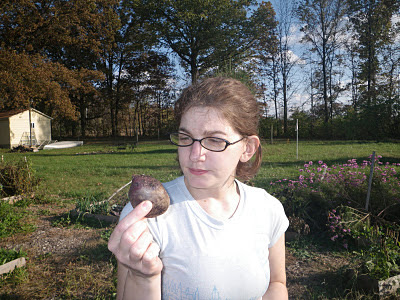
Asparagus!!! This plant is awesome to grow. I want to eat it now, the wait is killing me.
Sunflowers are great. We lost two but I planted some red ones from my friend Doug and
those just recenly started blooming. Smaller heads but much larger stalks.
Thanks, Doug!!

Here's a shot of the entire raised bed garden from the back of the yard.

The strip of plants centered in this photo are the beginnings of my
"beneficial insect habitat." I will post more about that later.

The potato box... in desperate need of more straw
and it's (now giant) companion horseradish.

Little yummy tomatoes!!! Patrick picked all the flowers off the plants
so they would grow taller so I am still waiting to try my tomatoes. He
doesn't mind because he thinks tomatoes are gross and won't eat them.

Our black-eyed peas. I really love this plant. It's very interesting.
You can just let the beans dry out on the plant and then harvest... so easy.

I am still amazed at how fast these things grow.
I think these are the costata zucchinis — you just cooked them with the flower.

All the squash in the front box is yellow, crook and straightneck.
The cabbage didn't form before it started getting really hot and now it's under
attack from flea beetles. Some of the squash leaves are showing signs of mildew.

Here are a couple protection plants. The leafy one in the background is
wormwood.I scattered it around the Cabbages hoping it would help deter the
beetles. I read somewhere that might help but from what I understand
wormwood is a better animal deterrent.

Lettuce and amaranth. Even though these lettuce varieties are growing
well through the heat they are still a bit bitter. The amaranth greens are
slightly bitter too but not enough to keep us from eating them.
This plant is very nutritious and is doing extremely well in the heat.
I love cooked greens with squash so I find this and lambs quarter are a
great substitute as the chard and kale dwindle in the drought.

I have never grown a sunflower. I am very excited about something
so small growing up to be this big and being able to provide so
much protein. I suppose the whole stalk will dry out and then I can
harvest the seeds. Hopefully it will be as easy as the black-eyed peas.

We don't even know what this is.... Patrick planted a whole bunch of
stuff and can't remember where. Oh well, some kind of squash I'm
guessing! I think it must be acorn or pumpkin. One might be a watermelon.

These are the first carrots we planted. One thing about carrots:
you have to keep planting them. I always forget.

The beginning of the hops wall! We may actually harvest a bit
this year. They are producing a lot already. We replanted the
grape that died and Patrick started training everything on the wires.

We planted some things right outside the compost pile. The vine
in front is a watermelon, I believe. And then okra and another squash plant.

Okra flower.

Here's the other back corner where we have the baby hazelnut hedge.
In the far back are the roses and a big watermelon patch. That must be a
wild grape on the fence. All those tall flowers are queen anne's lace
we left there for the hell of it. The patch now houses dozens of praying mantis =D

This is just a picture of the raised beds from the side to give
a better perspective of the yard. We have a 1/2 an acre but
the plants are really not taking up that much space. The plan
is to put in a pond where I am standing.






















































